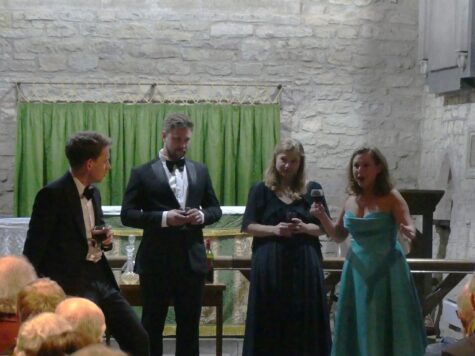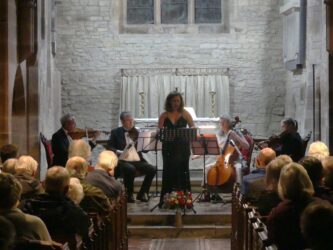 United Kingdom Corvedale Festival 2024 [3] – Opera Gala: Oksana Lepska (soprano), Samantha Lewis (mezzo-soprano), James Beddoe (tenor), Sam Young (baritone), Alex Postlethwaite, David Joyce (violins), Jane Park (viola), Ruth Henley (cello), Elizabeth Jones (double bass), Anna Kondrashina (flute), Damla Tuncer (oboe), Emily Newman (bassoon), Stien de Neef (harp), Bedwyn Lloyd Phillips (conductor). St Michael’s Church, Munslow, 27.9.2024. (CK)
United Kingdom Corvedale Festival 2024 [3] – Opera Gala: Oksana Lepska (soprano), Samantha Lewis (mezzo-soprano), James Beddoe (tenor), Sam Young (baritone), Alex Postlethwaite, David Joyce (violins), Jane Park (viola), Ruth Henley (cello), Elizabeth Jones (double bass), Anna Kondrashina (flute), Damla Tuncer (oboe), Emily Newman (bassoon), Stien de Neef (harp), Bedwyn Lloyd Phillips (conductor). St Michael’s Church, Munslow, 27.9.2024. (CK)

Mozart – Voi che sapete; Vedro mentr’io sospiro; Dove Sono (The Marriage of Figaro)
Puccini – Che gelida manina; Mi chiamano Mimì (La bohème)
Bizet – Habanera (Carmen); Au fond du temple saint (The Pearl Fishers)
Verdi – Bella figlia dell’amore (Rigoletto); Prelude; Di Provenza; Brindisi (La traviata)
Mascagni – Intermezzo from Cavalleria rusticana
Donizetti – Una furtiva lagrima (L’elisir d’amore)
Delibes – The Flower Duet (Lakmé)
The eventful final weekend of this year’s Corvedale Festival began with an Opera Gala. Of all the concerts, this was the one that seemed to generate the biggest buzz in the valley; St Michael’s Church in Munslow was all but full, and there was excitement in the air. This was not an occasion – as had rightly been the case in most of the other concerts – to throw at the audience music that was unfamiliar or hard to digest: a cursory glance at the programme above will show that it was a veritable basket of plums. At the end I spoke to one enthusiastic gentleman from Bridgnorth who has supported that town’s Haydn Festival for years: he was keen to attend more concerts in Corvedale in future. I had the impression that he was not alone – that quite a few others were made aware of what they had been missing. The future of small festivals (and large) can never be taken for granted: but I sincerely hope there will be a Corvedale Festival next year, and that many more will come and enjoy the riches on their doorstep – or, like the gentleman from Bridgnorth, from further afield.
Paul Henley, who directed the performances, made sure that no aria was simply stand-and-deliver (park and bark, as a Wagnerian once expressed it): the singers were in costume, there were essential props (a desk, a bottle of wine, a candle), and in each case the dramatic situation was made clear enough for a genuine whiff of opera – the total experience that this extraordinary art form can generate – to come across (the footlights, I almost said, but of course there weren’t any). In the arias from Marriage of Figaro the preceding recitatives were included, enabling the singers to draw us vividly into the drama. There were some highly effective and original strokes: in the duet from The Pearl Fishers the priestess Lėïa materialised onstage, making the love-triangle as visual as the music made it affecting. In short, we were transported.
A nine-piece pit band (five strings, three woodwind and harp) made splendid accompanists: and on their own they achieved a convincing small-orchestral sound with a fizzing Figaro Overture, a touching and sweet-toned Intermezzo from Cavalleria rusticana and the delicate Prelude to La traviata. They were conducted in lively fashion by Bedwyn Lloyd Phillips. The singers – all young, up-and-coming – were most impressive. The Latvian soprano Oksana Lepska was vocally powerful and instinctively dramatic, occasionally a touch squally in her upper register: a natural for spinto roles, though she also blended most sensitively with Samantha Lewis’s mezzo-soprano in The Flower Duet. She is an exciting singer, and I will look out for her future performances. I particularly liked Samantha’s lively Cherubino in Voi che sapete; and Sam Young’s imposing baritone was heard to great advantage in Di Provenza, Germont’s aria from La traviata. I have to say, though, that it was James Beddoe’s tenor that moved me most, both musically and dramatically: he made something really touching of Rodolfo’s Che gelida manina and Nemorino’s Una furtiva lagrima.
Music for Renaissance Viols – Linarol Consort (David Hatcher, Claire Horáček, Tim Lin). St Catherine’s Church, Tugford, 28.9.2024.
Paul Henley’s feeling that Tugford’s St Catherine’s Church is an ideal venue for early music was triumphantly borne out by the Linarol Consort’s performance at lunchtime on Saturday. Their recital consisted of 22 pieces for viol consort, designed to illustrate the origins and popularity of viol music in England in the first half of the sixteenth century – specifically at the court of Henry VIII (a dozen of the pieces were taken from the Henry VIII Manuscript).
A dry historical exercise? Anything but: partly because of the sheer beauty of sound these players produced, partly because of David Hatcher’s fascinating and disarmingly light-hearted commentary – it is a long time since I have heard an expert wear his learning so lightly. Many of the tunes, he said, were hugely popular – ‘the Yellow Submarines of their time’: and he pre-empted criticism by conceding that ‘you could be forgiven for thinking that many of the pieces are indistinguishable from many others’.
Many of the pieces – then as now – were songs about love, generally conforming to the medieval tradition of amour courtois (unattainable woman, besotted man). The pieces were short, but long enough to cast a spell. Tim Lin played bass viol, Claire Horáček tenor viol; David Hatcher played alto viol, alternating with treble viol in some pieces (and recorder in one). Their playing was beautifully expressive, their intonation immaculate.
It would take too long to enumerate everything that caught my ear, but De tous bien playne featured a notably lively and ornate alto viol fantasia over a ground (repeated bass line); the haunting Scots Yee gods of love was audibly a forebear of Scottish folk music, ending with a gentle Scots snap; there were a couple of pieces making play with the song L’homme armė (popularised in our day by Karl Jenkins). There was music of great beauty by William Cornysh the Younger, the best-known composer at Henry VIII’s court: in his Fa la sol there were teasing harmonic clashes and a nice Tierce de Picardie at the end. The Anne Boleyn Music Book provided a drinking song addressed to ‘companions of the grape’; a final group of pieces were attributed to Henry himself. In every case, the players’ absorption in and enjoyment of the music was palpable.
Mozart, P. Henley, Schubert: Oksana Lepska (soprano), Jarualda Quartet (Alex Postlethwaite, David Joyce [violins], Jane Park [viola], Ruth Henley [cello]). St Michael’s Church, Munslow, 28.9.2024.

Mozart – Quartet in C, ‘Dissonance’
Paul Henley – Tainstvennaya Lyestnitsa (The Mysterious Stair) world premiere
Schubert – Quartet No.14 ‘Death and the Maiden’
The Jarualda Quartet, who had opened the Festival more than a week earlier, returned on Saturday evening to close it. They opened – bravely – with Mozart’s ‘Dissonance’, last and greatest of his six ‘Haydn’ Quartets, so named because its sparse and almost atonal opening can provoke audience reaction: are they tuning up? Or are they just too tentative and hopelessly out of tune with each other? Eventually we emerged into C major sunshine, and we all settled down to half an hour of magnificent music.
Paul Henley’s work for soprano and string quartet is a setting of a poem by Anna Akhmatova, inspired by hearing Galina Vishnevskaya singing Villa-Lobos’s Bachianas Brasileiras No.5 on the radio (a work that those of my generation are more likely to have heard sung by Joan Baez). Akhmatova entitled the poem Slushaya pyenie (Listening to Singing): but in choosing his title Henley has responded directly to the final image of Yvonne Appleby’s marvellous translation of the poem (rather wonderfully, Appleby was present at the performance). Yeats-like, the ‘mysterious stair’ suggests that art – Vishnevskaya’s voice – can summon us to transcendence: a journey beyond death into the unknown.
The poem is sung in the original Russian: Oksana Lepska’s ringing conviction would have filled a church three times the size – which seemed to me, knowing Vishnevskaya’s voice only from her imperious performance in Britten’s recording of his War Requiem, entirely appropriate. The string players evolved a spare tapestry of sound from the viola’s initial seven-note rise and fall; they sustained the intensity in the passages where the voice was silent – a rhythmic ostinato, ghostly violin harmonics after a low cello trill – right up to the shining climax, when the soprano seems to ascend onto the stair.
Henley’s work is one of great beauty, wildness, imagination and power. Sometimes, on hearing an entirely new piece of music, one has a kind of frisson which suggests that one is listening to a masterpiece. I experienced that here.
The Jarualda Quartet finished as they had begun, with Schubert. Their playing of ‘Death and the Maiden’ took no prisoners: they projected it with all the force and passion they could muster. Their performance made me realise what a physically demanding work it is to play. A glorious end to a lovely, friendly and consistently stimulating festival.
Chris Kettle
For more about the Corvedale Festival click here.
